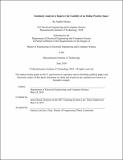| dc.contributor.advisor | Justin Reich. | en_US |
| dc.contributor.author | Mionis, Natalie. | en_US |
| dc.contributor.other | Massachusetts Institute of Technology. Department of Electrical Engineering and Computer Science. | en_US |
| dc.date.accessioned | 2019-11-22T00:04:13Z | |
| dc.date.available | 2019-11-22T00:04:13Z | |
| dc.date.copyright | 2019 | en_US |
| dc.date.issued | 2019 | en_US |
| dc.identifier.uri | https://hdl.handle.net/1721.1/123047 | |
| dc.description | This electronic version was submitted by the student author. The certified thesis is available in the Institute Archives and Special Collections. | en_US |
| dc.description | Thesis: M. Eng., Massachusetts Institute of Technology, Department of Electrical Engineering and Computer Science, 2019 | en_US |
| dc.description | Cataloged from student-submitted PDF version of thesis. | en_US |
| dc.description | Includes bibliographical references (pages 56-57). | en_US |
| dc.description.abstract | I develop a new confusion measurement feature for use in Teacher Moments, an online practice space for teachers in training. Teacher Moments, developed at the Teaching Systems Lab (TSL) at MIT, is an online platform that simulates difficult classroom experiences. Teacher candidates can use this platform to gain experience handling realistic, uncomfortable situations that they may eventually face in a real classroom. Teacher educators who instruct teacher candidates can then review teacher candidates' responses and progress in Teacher Moments. The sentiment analysis feature detects confusion in responses to Teacher Moments scenarios. This feature, named the confusion measurement tool, allows teacher educators to identify teacher candidates who may be exhibiting confusion. By identifying confused teacher candidates, teacher educators can then modify their class activities or provide additional attention to any teacher candidates who may need it. I find that the confusion measurement tool is effective at identifying responses that do not exhibit confusion, but is less effective at identifying confused responses. I also find that the confusion measurement tool helps teacher educators use their time more effectively when analyzing responses to Teacher Moments scenarios. | en_US |
| dc.description.statementofresponsibility | by Natalie Mionis. | en_US |
| dc.format.extent | 57 pages | en_US |
| dc.language.iso | eng | en_US |
| dc.publisher | Massachusetts Institute of Technology | en_US |
| dc.rights | MIT theses are protected by copyright. They may be viewed, downloaded, or printed from this source but further reproduction or distribution in any format is prohibited without written permission. | en_US |
| dc.rights.uri | http://dspace.mit.edu/handle/1721.1/7582 | en_US |
| dc.subject | Electrical Engineering and Computer Science. | en_US |
| dc.title | Sentiment analysis to improve the usability of an online practice space | en_US |
| dc.type | Thesis | en_US |
| dc.description.degree | M. Eng. | en_US |
| dc.contributor.department | Massachusetts Institute of Technology. Department of Electrical Engineering and Computer Science | en_US |
| dc.identifier.oclc | 1127911798 | en_US |
| dc.description.collection | M.Eng. Massachusetts Institute of Technology, Department of Electrical Engineering and Computer Science | en_US |
| dspace.imported | 2019-11-22T00:04:12Z | en_US |
| mit.thesis.degree | Master | en_US |
| mit.thesis.department | EECS | en_US |
